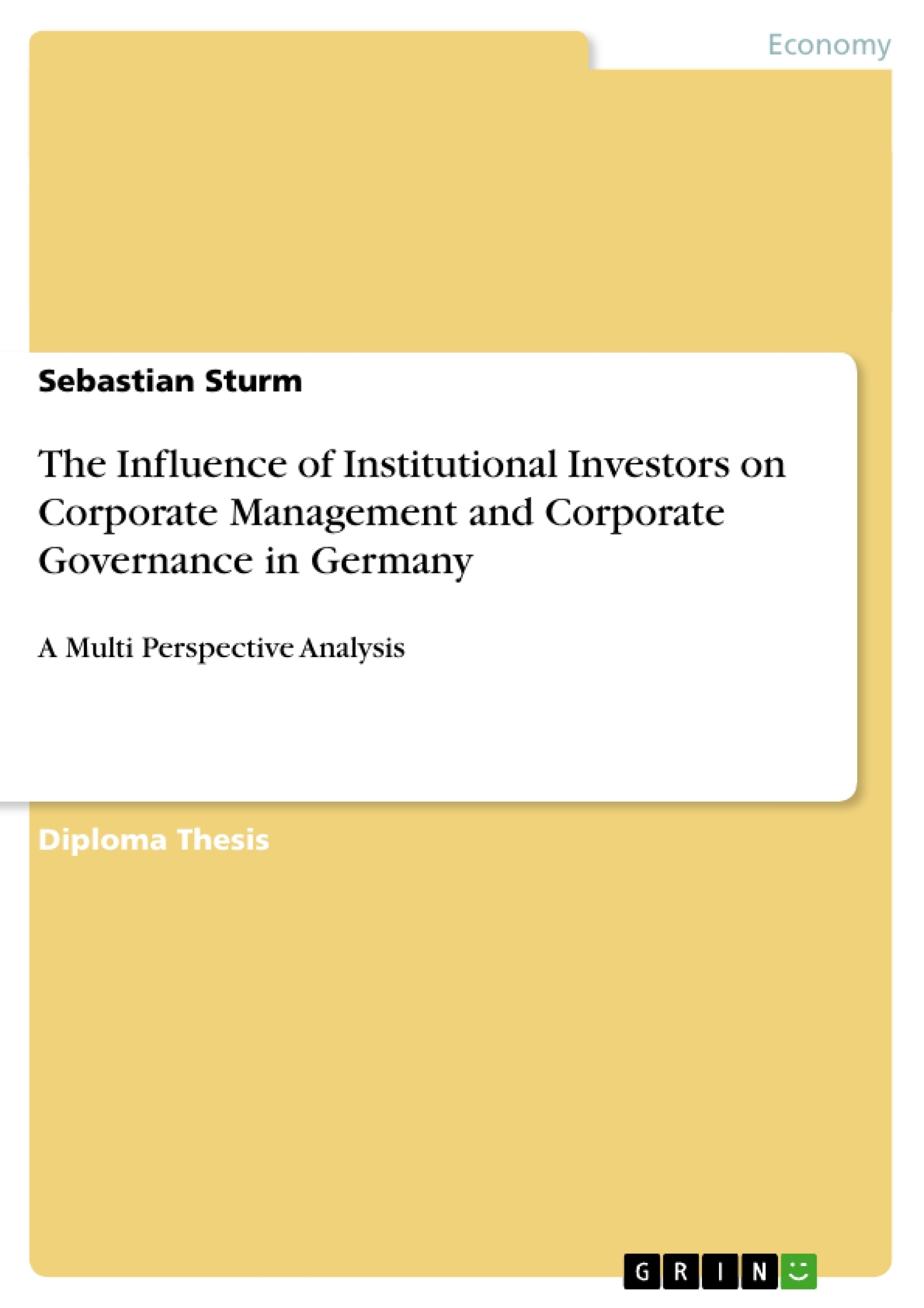Corporate management and corporate governance are becoming more and more crucial in today’s successful economies. With the increasing relevance of capital markets this subject
comes more into the focus of the public. Particularly, the fast growing importance of institutional investors is a key factor which helps to explain the changing attitude of managers
towards shareholders and corporate governance. In conjunction with the German capital market, a wide variety of mismanagement in
German public limited companies has revealed shortfalls of German top-management and corporate control in the last decade. This development was of fundamental importance for the development of the German Corporate Governance Code. Hence, the basic underlying
of corporate governance can be attributed to a conflict between the management of a listed corporation and its owners. More precisely, this conflict arises because the management does not adequately comprise the interests of shareholders. In Germany, assets under management of professional investors have increased at 92 percent from 1990 to 2001.1 In addition, a growing administration of private savings by professional fund managers as well as the intensified exercise of influence by institutional
investors on corporate governance and corporate management respectively corporate strategy is observable. Similarly, a growing importance of institutional investors could be observed
in the United Kingdom as well as in the United States. Within academic literature, the issue of activism by institutional investors in Germany is analyzed little, so far. Furthermore, there are only a few surveys on the outcome of the influence by institutional investors on corporate management. Therefore, this thesis aims to answer the following questions:
1. How was the development of shareholder activism in Germany and how can it be characterized and explained?
2. Is shareholder activism a superior tool in relation to the market of corporate control to solve the principal-agent problem?
3. What do institutional investors demand from German corporations and in particular from corporate management?
4. Which options do institutional investors have to influence corporate management?
5. How are these options for activism covered by the German Corporate Governance
Code and the German legal framework?
6. What is the optimum corporate governance from an institutional investor’s angle?
7. What is the empirical outcome?
Inhaltsverzeichnis (Table of Contents)
- 1. Introduction
- 2. Methodology
- 3. Theoretical Differentiation of the Object of Investigation
- 3.1 Shareholder Activism
- 3.2 Investors
- 3.2.1 Institutional Investors
- 3.2.2 Non-Institutional Investors
- 3.3 Corporate Governance
- 3.4 Corporate Management
- 4. Shareholder Activism by Institutional Investors in Germany – Status Quo
- 4.1 The Growth of Institutional Share Ownership
- 4.1.1 Renunciation from the "Wall Street Walk"
- 4.1.2 Liquidation of “German Inc.”
- 4.2 The Principal - Agent Theory and Agency Costs
- 4.2.1 The Principal – Agent Conflict in Listed Companies
- 4.3 Demands of Institutional Investors on Corporate Governance
- 4.4 Importance of Instruments used by Institutional Investors
- 4.4.1 External Instruments
- 4.4.2 Internal Instruments
- 4.5 Intermediary Result
- 4.1 The Growth of Institutional Share Ownership
- 5. Explanatory Models for Shareholder Activism by Institutional Investors
- 5.1 Single-Variable Explanation Approaches
- 5.1.1 Size of Stakes and Cross Holdings
- 5.1.2 Legal Explanations
- 5.1.3 Aftermarket Liquidity
- 5.1.4 Portfolio Management
- 5.2 Multi-Variable Explanation Approaches
- 5.2.1 The Model of Shleifer and Vishny
- 5.2.2 The European Governance Network Approach
- 5.3 Intermediary Result
- 5.1 Single-Variable Explanation Approaches
- 6. The Corporate Governance System in Germany
- 6.1 The Need for Information versus the Protection of Information
- 6.2 Direct Firm Level Monitoring
- 6.2.1 Institutional Investors and the German Annual General Meeting
- 6.2.1.1 Commercial Banks
- 6.2.1.2 Mutual Funds
- 6.2.1.3 Insurance Companies
- 6.2.2 Indirect Firm Level Monitoring
- 6.2.2.1 Takeovers or the Market for Corporate Control
- 6.2.2.2 Board Composition and Board Structure in Germany
- 6.2.3 Institutional Investors and Board Independence
- 6.2.1 Institutional Investors and the German Annual General Meeting
- 6.3 Implementation of the German Corporate Governance Code
- 6.4 Corporate Governance in an International Context
- 6.5 Intermediary Result
- 7. Empirical Results on the Success of Activism by Institutional Investors
- 7.1 Evidence on the Effects of Shareholder Activism in the USA
- 7.2 Evidence on the Effects of Shareholder Activism in Germany
Zielsetzung und Themenschwerpunkte (Objectives and Key Themes)
This thesis aims to provide a multi-perspective analysis of the influence of institutional investors on corporate governance and corporate management in Germany. It investigates the status quo of shareholder activism by institutional investors, explores explanatory models for this activism, and examines the German corporate governance system in this context.
- The role of institutional investors in German corporate governance
- The impact of shareholder activism on corporate management decisions
- Explanatory models for shareholder activism by institutional investors
- The effectiveness of different instruments used by institutional investors
- A comparison of the German corporate governance system with international standards
Zusammenfassung der Kapitel (Chapter Summaries)
Chapter 1 introduces the research topic and outlines the methodology. Chapter 2 details the methodological approach. Chapter 3 provides a theoretical framework, defining key concepts such as shareholder activism, institutional investors, corporate governance, and corporate management. Chapter 4 analyzes the current state of shareholder activism by institutional investors in Germany, including the growth of institutional share ownership and the use of various instruments. Chapter 5 examines explanatory models for shareholder activism, focusing on both single-variable and multi-variable approaches. Chapter 6 delves into the specifics of the German corporate governance system, including direct and indirect firm-level monitoring, board composition, and the implementation of the German Corporate Governance Code. Chapter 7 presents empirical results on the success of shareholder activism, comparing evidence from the USA and Germany.
Schlüsselwörter (Keywords)
Institutional investors, shareholder activism, corporate governance, corporate management, Germany, agency costs, principal-agent theory, corporate governance code, empirical analysis.
- Quote paper
- Sebastian Sturm (Author), 2008, The Influence of Institutional Investors on Corporate Management and Corporate Governance in Germany , Munich, GRIN Verlag, https://www.grin.com/document/125705



